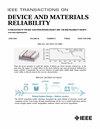评估DRAM CMOS外围器件的可靠性:比较BTI和TDDB的交流和直流条件
IF 2.3
3区 工程技术
Q2 ENGINEERING, ELECTRICAL & ELECTRONIC
IEEE Transactions on Device and Materials Reliability
Pub Date : 2025-08-04
DOI:10.1109/TDMR.2025.3595501
引用次数: 0
摘要
本文深入分析了DRAM CMOS外围器件中的快速偏置温度不稳定性(BTI)和时间相关介电击穿(TDDB),重点是NMOS和PMOS晶体管。使用快速测量技术,我们评估了BTI在直流和交流应力模式下的降解。我们的研究结果表明AC - BTI-Mode B (NBTI)具有频率无关性。交流模式(A和B)的正BTI (PBTI)也表现出频率无关性。此外,该研究还揭示了NMOS和PMOS器件的TDDB行为趋势。与直流相比,PMOS TDDB在较高频率下性能有所提高,而NMOS TDDB在较低频率下性能有所下降,但在较高频率下性能有所提高。这些结果表明,需要进一步研究这些可靠性机制之间的相关性,以制定有效的缓解策略。通过探索BTI和TDDB之间的关系,我们的目标是增强对这两种相似机制的认识(从器件在应力期间的角度来看)本文章由计算机程序翻译,如有差异,请以英文原文为准。
Assessing the Reliability of DRAM CMOS Periphery: Comparing AC and DC Conditions for BTI and TDDB
This paper presents an in-depth analysis of fast Bias Temperature Instability (BTI) and Time-Dependent Dielectric Breakdown (TDDB) in DRAM CMOS periphery devices, focusing on NMOS and PMOS transistors. Using rapid measurement techniques, we evaluate BTI degradation under both DC and AC stress modes. Our findings reveal that AC Negative BTI-Mode B (NBTI) shows frequency independence. Positive BTI (PBTI) in AC mode (A and B) also demonstrates frequency independence. Additionally, the study uncovers trends in TDDB behavior for NMOS and PMOS devices. PMOS TDDB performance improves at higher frequencies compared to DC, while NMOS TDDB shows degradation at lower frequencies with improved performance at higher frequencies. These results suggest a need for further investigation into the correlation between these reliability mechanisms to develop effective mitigation strategies. By exploring the relationships between BTI and TDDB, we aim to enhance the knowledge of those two similar (from the device point of view during stress) mechanisms
求助全文
通过发布文献求助,成功后即可免费获取论文全文。
去求助
来源期刊

IEEE Transactions on Device and Materials Reliability
工程技术-工程:电子与电气
CiteScore
4.80
自引率
5.00%
发文量
71
审稿时长
6-12 weeks
期刊介绍:
The scope of the publication includes, but is not limited to Reliability of: Devices, Materials, Processes, Interfaces, Integrated Microsystems (including MEMS & Sensors), Transistors, Technology (CMOS, BiCMOS, etc.), Integrated Circuits (IC, SSI, MSI, LSI, ULSI, ELSI, etc.), Thin Film Transistor Applications. The measurement and understanding of the reliability of such entities at each phase, from the concept stage through research and development and into manufacturing scale-up, provides the overall database on the reliability of the devices, materials, processes, package and other necessities for the successful introduction of a product to market. This reliability database is the foundation for a quality product, which meets customer expectation. A product so developed has high reliability. High quality will be achieved because product weaknesses will have been found (root cause analysis) and designed out of the final product. This process of ever increasing reliability and quality will result in a superior product. In the end, reliability and quality are not one thing; but in a sense everything, which can be or has to be done to guarantee that the product successfully performs in the field under customer conditions. Our goal is to capture these advances. An additional objective is to focus cross fertilized communication in the state of the art of reliability of electronic materials and devices and provide fundamental understanding of basic phenomena that affect reliability. In addition, the publication is a forum for interdisciplinary studies on reliability. An overall goal is to provide leading edge/state of the art information, which is critically relevant to the creation of reliable products.
 求助内容:
求助内容: 应助结果提醒方式:
应助结果提醒方式:


